Pep Guardiola’s Manchester City Tactics 2020-23
When I should replicate Pep Guardiola’s Manchester City tactics in Football Manager I have decided to offer simply a few of the Manchester City tactics under Pep Guardiola. rather than mimic all the different variations.
The tactics I’ve decided to share is his 4-3-3 system with an inverted wingback and his brand new 3-2-4-1 system that we have covered above. I feel these two systems are his main ones, despite he has also used 4-2-3-1 and 3-4-2-1 at times but basically these are just a question of moving a player up and down with a minor change in player roles and duties.
Our tactical analysis of Pep Guardiolas Manchester City tactics and the insight to Pep’s new 3-2-4-1 formation provides a great foundation before looking at how we recreate Pep Guardiola’s Manchester City 2022/23 tactics in Football Manager 2023.
Download FM24 Pep Guardiola Man City Tactics
Enter the world of Pep Guardiola’s mastermind. Play the new football meta in Football Manager 2024 with Passion4FM’s replication of Pep Guardiola’s Manchester City 3-2-4-1 tactics from 2022/23 season, or play with the traditional Pep Guardiola 4-3-3 tactic in FM23.
Released: 07.06.2023 – FM23 DOWNLOAD
Updated: 26.11.2023 (For Football Manager 2024)
Team Instructions – In Possession
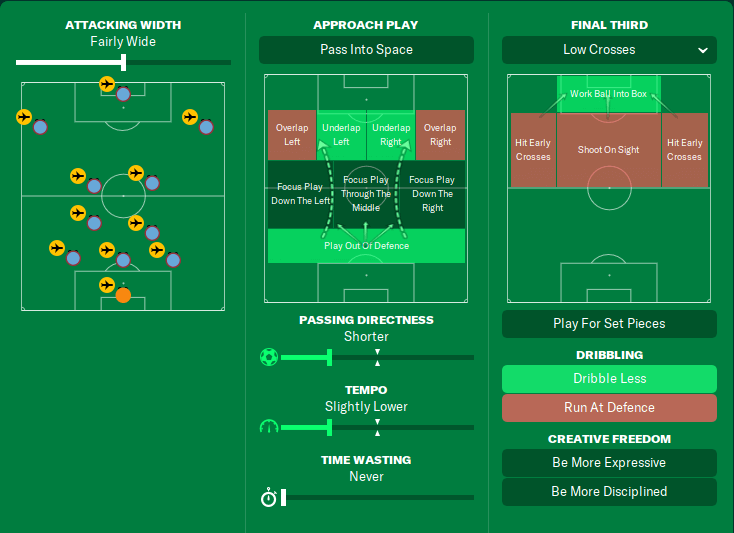
Passing Directness & Final Third Entries
The playing style of Pep Guardiola revolves around short intricate passing combinations where the players look to work the ball forward by playing out of defence. His short passing football is aimed at using the ball to create spaces and thereby move the opposition to come to goalscoring opportunities.
In Football Manager 2023, we can mimic Pep Guardiola’s brand of football by utilizing the Tiki-Taka tactical style template and then make small tweaks to it.
To replicate how Manchester City behaves with the ball in possession we have two options when it comes to the passing directness to get the result we want. Since Man City has a track record of 64.7% average possession per game you could either go with a Much shorter passing directness to ensure the team retains possession without taking any necessary risk to create goalscoring opportunities.
The other option, which I’ve gone by, is to use Shorter Passing Directness to make sure the team still retains possession but attacks a bit more vertically when giving a potential chance to enter the final third. As I see it, it’s a matter of progressing the ball forward sooner rather than later, especially when the opposition teams are likely to park the bus and play with an extremely low block against Man City.
At least, when we have such an attacking threat as Erling Haaland on top, who can both use his quickness to move behind the defensive line, or drop deep, hold up the ball and play in the inverted wingers in a more direct attacking approach.
I loathe all that passing for the sake of it, all that tiki-taka. It’s so much rubbish and has no purpose. You have to pass the ball with a clear intention, with the aim of making it into the opposition’s goal.
It’s not about passing for the sake of it. Pep Guardiola
If we look at the real-life possession stats, Man City 2022/23 is topping the overall possession statistics in European football according to Whoscored.com with 65.2% possession. According to FBref.com they makes the most progressive passes in the entire Premier League with 2073 passes or 54.6 passes per game that is either completed into the penalty area or travels at least 10 yards from its furthest point in the last six passes.
Their average length is far from shortest in Premier League 22/23 by ending at 27.5 yards, and at the same time they are less likely to launch passes over 40 yards by attempting the third lowest long passes per game (7.55 with a success rate of 44.6%).
Manchester City is also the only team in Premier League with more than 11000 completed short passes at a success rate of 90.9%. These are passes between 5 to 15 yards which could tell a story of a much shorter to shorter passing directness, but at the same time they makes nearly 10000 total passes this season that are between 15 to 30 yards – or 13 to 26 meters which makes me interpret their passing game how I have done it.
NB! Much shorter passing directness is a great option if you like to control the match without taking too much risk. Perhaps you’d like to close off the match by retaining possession and instruct your players to keep hold of the ball as often as possible.
PS. By using shorter passing directness, I’m able to instruct specific players (or positions) to prioritize retaining the ball by asking them to make much shorter passes, as I’ve done for the Stones role.
By activating the Dribble Less instruction we can ensure the team adopts a pass-first mentality. Despite it’s not uncommon from the inverted wingers to cut inside and carry the ball when coming in a one-on-one situation, I’ve decided to reduce the number of dribbles by instructing the team to pass the ball rather than run with it into attacking situations.
By selecting ‘Dribble Less’ you’ll increase the number of one touch passes, or ensure the team makes more one-two’s to pass their way through the lines at an higher speed. The players will zig-zag the ball through the opposition lines through intricate passing combinations.
However, you can untick Dribble Less if you want your team’s players to more often run with the ball – a strategy that Pep has often relied more on after signing players gifted with dribbling and carries.
I want intricate passing as they move forward, not too fast initially, so that none of our men ends up in the wrong place. A highly-organised advance until they reach the centre and then boom!Pep Guardiola, Pep Confidential: The inside Story of Pep Guardiola’s first season at Bayern Münich
Width
Despite of slightly increasing the passing directness from Much shorter to shorter in the Tiki-Taka tactical style, the biggest alteration I’ve done is to the Attacking width setting.
Rather than focusing the play through the middle, Man City have a tendency to play with a much wider width. Whether it is to focus play down one of the flanks to open up space on the opposite or to stretch the opposition to increase the space between the channels to overload and work the ball through the half space channels by movements and through balls with the intention to set up the wingers in a situation where he isolates the opposing fullback.
With a positive mentality already contributing to the team’s width, I’ve interpreted Man City’s attacking width in Football Manager 2023 as the default Fairly Wide. Here you can always increase the width to force the team to combine more often down the flanks.
What I’ve done to ensure we got the appropriate width to create chances through the half space channels is to instruct the inverted wingers to stay wider and hold position. This will instruct them to stay on the outside of the opposing fullbacks position regardless of how wide or narrow they play. This ensures the formation transit from a 3-2-4-1 into a 3-2-5 formation when play enters the final third.
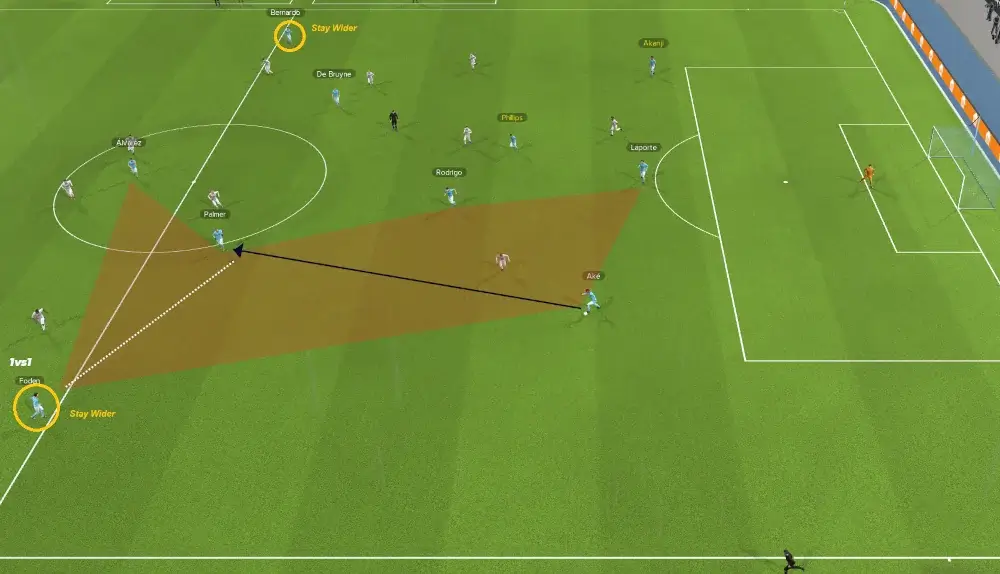
This is especially the case when the team is building out from the back, as the below illustration of the classic Pep Guardiola 3-2-4-1 tactic shows.
With a Fairly Wide width, the aim is to create space in the middle of the pitch for the two central midfielders to receive the ball. Since our shape is rather narrow, compared to a traditional back four system with overlapping fullbacks, we need to balance the width more appropriately.
Approach Play
At Barcelona, Pep Guardiola was associated with the Tiki-Taka style of play where “possession was 9/10” of the law. After moving to Bayern Münich Pep himself tried to distance himself from the pass-heavy brand of football where the team retained the ball for possession sake, like passing the ball without any clear intent.
However, Pep Guardiola’s intention was to play a short simple passing game with lots of combination to attract the opposition to one side before attack on the opposite flank where new found space has been created.
You overload on one side and draw them in so that they leave the other side weak. And when we‘ve done all that, we attack and score from the other side.
That’s why you have to pass the ball, but only if you’re doing it with a clear intention. It’s only to overload the opponent, to draw them in and then to hit them with the sucker punch. That’s what our game needs to be.Pep Guardiola, Pep Confidential: The Inside Story of Pep Guardiola’s First Season at Bayern Munich
This is something we have seen at Manchester City all through the season regardless of whether Pep Guardiola opts to use a 3-2-4-1 tactic, 4-3-3 formation or a 4-2-3-1 system.
If we take a closer look at Man City’s 4-0 trashing against Real Madrid in the Champions League semi final, they only prioritized working the ball down the right or left flank at 34% and 35%. Against Bayern Münich (3-0) it was 37% left side and 39% right side with only 25% of play coming through the middle.
This reveals that Pep Guardiola is no stranger at focusing play down a specific side. It all depends on taking advantage of opposition weakness. This means that you’re more than welcome to instruct your team to focus play down a specific side according to any opposition match analysis you’ve done, but I haven’t enabled that for any of the tactics.
Instead, I want the team to combine through the middle with penetrating runs coming from deep on each side of the striker.
By instructing the players to look for underlaps any wide players will hold up the ball and look for any passing options between the lines. It may be third man runs and other movements in the channels, or passes to a player, like Kevin de Bruyne, who finds pocket of spaces to flick the ball towards the striker.
A positive mentality, Dribble Less and Look for underlaps, provides a magnificent foundation to play some amazing attacking pass and move football. Couple it with work the ball into the box and you’ll get some really entertaining football.
When entering the final third, Manchester City looks to work the ball into the box by passes rather than shoot on sight. In total, they have made 1770 passes into the final third, which is definitely the highest in PL 2022/23 as well as making the third most highest passes into the 18 yard area with 445 versus Arsenal’s 459.
On top of that, Manchester City completes 2.47 through balls per game (third highest) – something that paints the picture of the team’s passing directness and intent when entering the final third.
The combination of work the ball into the box and look for underlaps will somehow reduce the tempo of the game. While the midfielders will hold onto the ball in settled attacks and play a supporting pass if there are not any available passing options up front, the wingers and wide players will initiate more diagonal passes towards the center of the pitch at the first opportunity in attempt to come to a goalscoring opportunity.
This increases the likeliness of turnovers and could result in deadly counter-attacks. This is especially the case if the opposition uses a double pivot in front of the center backs. To solve that, I would suggest removing Look for Underlaps when facing a 4-2-3-1DM or a 5-2-1-2DM AM and instead try to focus play down the flanks in order to stretch them apart as there may be difficult to bypass the defensive midfielders without trying to isolate them.
In Transition
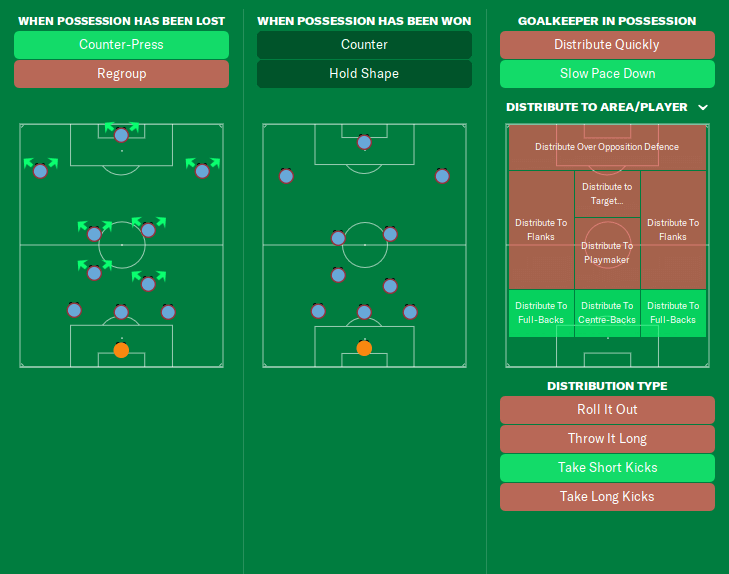
When the team is in defensive transition we want to instruct our players to immediately press the opposing player as soon as the ball is lost. By enabling the counter-press instruction, the closest players around the ball carrier will step out of their position to try to reduce the time the opposing player has to pick out a pass.
Counter-pressing is the fundamental tool any possession team has to affect the moment of chaos – those situations between being in possession of the ball and without it. In some situations, counter-pressing can be a tool to delay the opposition’s counter-attacking initiatives.
Depending on the pressing level and specific player instructions, the number of players who looks to close down can vary. The risk with counter-pressing enabled is that player’s step out of their position meaning it is easier for the opposition team to bypass press and counter-attack if they are composed and got great ball control (first touch, dribbling and technique).
But counter-pressing can be wonderful tool to win back the ball high up the pitch and dominate the opposition on their own half. It only requires a bit of attention on the training ground working on ‘Technical – Trigger Press’, ‘Defending – Defending from the front’ and ‘Defending – Engaged’ to improve players decision-making, aggression, positioning and tackling.
Out of Possession
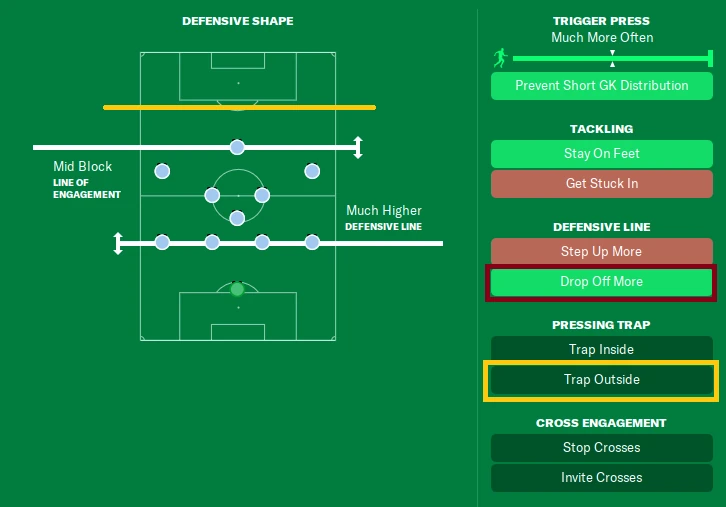
When out of possession, I want the the team to stay compact. In my tactics, I’ve gone for a high defensive line with a high line of engagement to reduce the meters between the lines. To avoid the opposition to play through your lines, it’s beneficial to limit the space between the midfield and attacking line – especially since I want to press the opposition high up the field by closing down the defenders.
At Manchester City, Pep Guardiola has varied the press by using anything from a high block to a mid high block. By reducing the line of engagement to a mid block you’ll be able to provide more space for the attacker to make counter-attacking runs behind the defensive line.
One of the main weaknesses with Pep Guardiola’s tactic over the years has been the vulnerable area behind the defensive line. His tendencies to play with an extremely high line has changed upon the years. With so many good teams in England and in Europe to counter-attack against Man City, Pep has been forced to lower his defensive line.
In some matches he would use a mid block that prioritize the team to stay deeper and remain control of the opposition by denying space behind the defensive line. Against Bayern Münich for instance, Man City had only 44% possession and completed only 373 passes at 80% accuracy – despite winning 3-0.
This tells us that Pep has become more cautious after recent Champions League failures by trying to win games with a gung-ho attacking approach.
If you experience a lot of over-the-top passes, I recommend you to alter the defensive line from the default Higher to Standard. or change the line of engagement to Mid block to make the team even more compact.
With an higher risk of getting countered on, specially when there are more players looking to press the ball as quickly as possible after losing it, I have found it necessary to ask the defensive line to drop off as soon as possible if there’s no chance of regaining possession immediately.
To ensure the most effective pressing, Pep Guardiola has established a four to six second rule. In order to regain possession, or engage the opposition in a manner that they aren’t able to swiftly and uninterruptedly go from defensive transition to attacking transition, Pep asks his team to immediately press the ball carrier. By triggering press more often, two to three players will engage the opponent on the ball to try to win back the ball as high up the pitch as possible.
If the team is unable to recover the ball within that time period, the team will need to move back into a defensive shape to protect the goal.
To succeed with Peps pressing philosophy it’s a fine balance between how much the players should close down and the compactness they need to press as an organized unit.
Close down too much and too often and the players will be drawn out of position – something that gives loopholes in the system which the opposition can take advantage of.
What I’ve done is to ask the team to trigger press more often to try to win back the ball quickly when there’s a false touch, if the player has their back towards goal or has not fully control of the ball, with Drop Off More and Trap Inside.
With Drop Off More enabled, the team will defend closer to its own goal when in defensive phase and encourage the defenders to track back into their defending shape if counter-pressing doesn’t work. In some ways it helps to avoid some of those long balls over the top as the defenders are more concerned at holding position or track back and deal with attacking threats quicker.
Drop off more is probably a bit counter-intuitive to the style of pressing we incorporate, but looks to ensure the player’s aren’t conceding even more space behind the defensive line which the opposition can take advantage of.
Instead, they will slightly drop off and keep control of any forward movements and be prepared for any attacking initiatives such as long balls from the opposition.
To better remain control of the center, I see it beneficial to trap the opposition outside. This will instruct the wingers to press towards the flank and thereby helps to create a compact unit that’s hard to penetrate on. At the same time, it will provide better circumstances to regain possession in the second and third situation as players are closer together and better able to create 3vs2 situations out of possession.
Selecting the trap outside instruction is highly useful due to the box midfield where I have four players in the center. Basically, this instruction is perfect for narrow systems like the 3-2-4-1 with more players in the middle of the pitch than on the flanks.
To ensure the team defends narrower and protects the center of the pitch, I’ve instructed my team to Invite Crosses. This will see your defenders stay narrower than usual and conceive space down the flanks, but essentially gives the opposition team the chance to play the ball as far as way from goal as possible – where it’s less dangerous for them to have possession.
NB! Trap outside, Invite Crosses and Drop Off More are instructions that needs to be considered depending on the opposition’s strengths and could easily be turned off depending on any opposition match analysis you’ve done. For instance, you may want to un-tick Invite Crosses against a team who got excellent Crossers and Headers and are playing with a system who looks to overlap down the wings as they might cause real headaches for you.
At the same time, Drop off more might be the wrong approach if you’re facing a great possession-oriented team who might not favor long balls over the top but requires less space and time for the midfielders and defenders to pick out a pass.
Pep Guardiola’s Manchester City 22/23 3-2-4-1 Tactics
The Pep Guardiola’s Manchester City 22/23 3-2-4-1 tactics comes in three different variations – all depending on the opposition’s shape and their use of width.
The team instructions for those three 3-2-4-1 tactics is basically similar. All I’ve done is make brief alterations to the player roles, their positioning and instructions. The minor differences in tactical setup gives you further options to select the system that fits your team and your attacking intent and willingness to take risk in possession to score more goals.
There are many similarities between the different 3-2-4-1 tactics I’ve created.
Both the Classic 3-2-4-1 tactic and the 3-2-2-3 Box Midfield, that you will learn more about below, aims to penetrate the opposition through the five channels with lots of movements and overloads that leads to more chances and shots on target.
Both system defends with 3 and a half player, or a second pivot in front of the back three. Both systems looks to take advantage of players moving between the channels or between space, regardless of the player is classified as a central midfielder or an attacking midfielder.
At the same time, both system creates a 3-2-5 shape in possession, or will profit from five forwards when play enters the final third.
The major difference is how it affects the opposition team and the risk you take in possession to score more goals, or come to goal-scoring chances.
But without any further ado, let’s take a closer look at the three different Pep Guardiola’s Manchester City tactics available to download below.
READ MORE | Download Football Manager 2023 Pep Guardiola Barcelona Tiki-Taka Tactics
Football Manager 2024 Pep Guardiola’s Man City John Stones 3-2-4-1 Tactic
With positional play and player rotations added in Football Manager 2024, we have a better foundation to re-create Pep Guardiola’s Man City John Stones 3-2-4-1 tactic as we have the option to use a libero in a back four system.
Below is my interpretation of the John Stones 3-2-4-1 tactic which ultimately replaces all the other variations of Pep Guardiola Man City tactics released for FM23. Frankly, I habe ot put any effort on the 3-2-2-3 box midfield tactic since positional play in FM24 will ensure you have a box midfield when using the libero.
The Football Manager 2024 version of Pep Guardiola’s Man City 2022-23 tactics combines the element from all previous tactics released for FM23 – from the 3-2-2-3 box midfield to the 3-2-4-1 attacking variant with two AMC’s, this new 4-3-3 formation will behave like a 3-2-4-1 or a 3-2-5 system in attack whilst defending in a 4-1-4-1 shape.

The shape of this 4-3-3 tactic will change into a 3-2-5 shape in possession of the ball. The two Mezzala’s will look to overload the half spaces, while the Inverted Wingers will stay wide and provide the width.
The new player role of Football Manager 2024, the Inverted Fullback enables us to defend with a back three while the libero pushes up into the midfield, as the below screenshot illustrates.
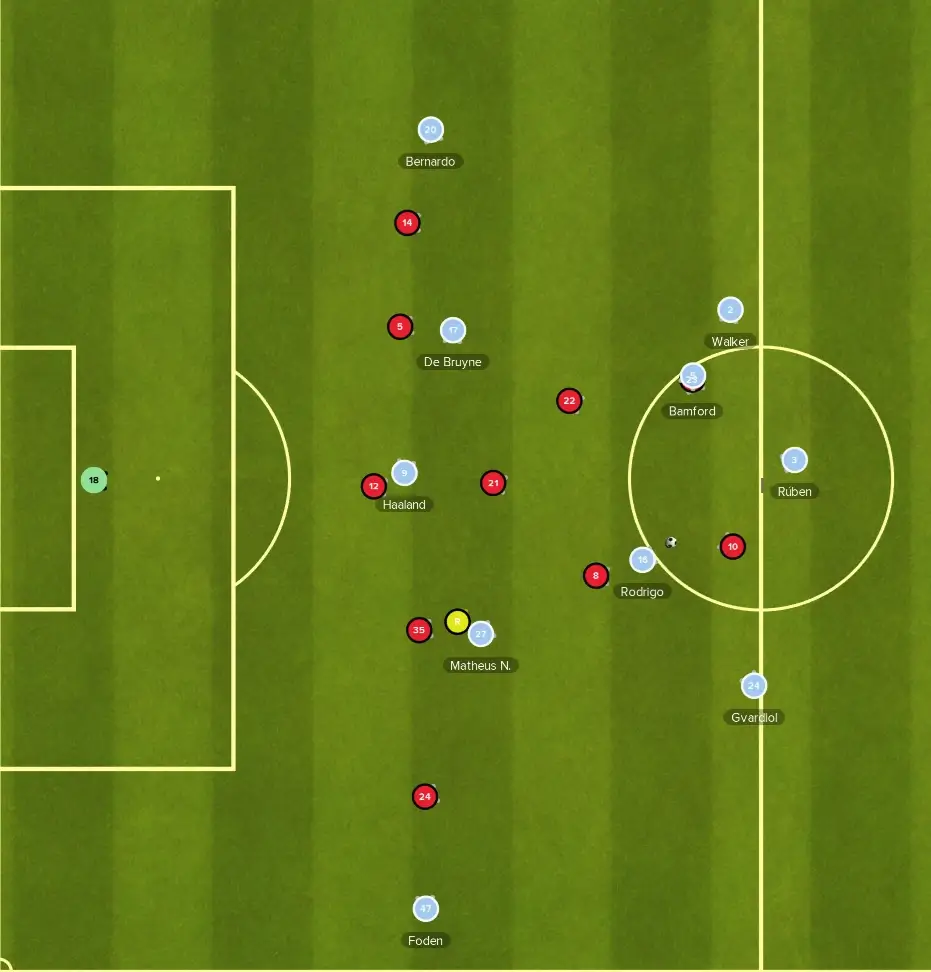
The wingers will provide the width of the system and trying to pin back the opposing fullbacks into a one-on-one situation where your players got qualitative superiority – acceleration, pace, dribbling, agility, technique and flair.
Gvardiol and Walker are Inverted Fullbacks who will move inside from the DR and DL position to protect against counter-attacks by moving closer to the center.
Average Position:
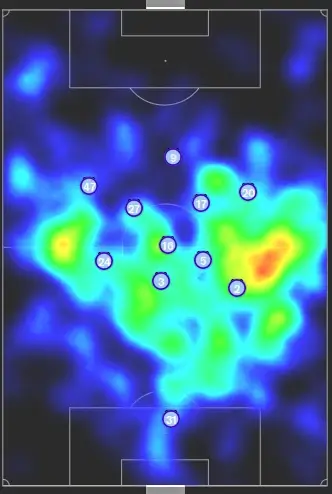
Player Roles & Instructions [FM24]
GK: Sweeper Keeper – Support
Player Instructions: Pass it Shorter (& Tackle Harder)
Ive selected a sweeper-keeper on support to try to copy Ederson’s style of play. Since he’s a goalkeeper who solely doesn’t pass the ball short but may look for counter-attacking initiatives when the opposition press high, or the goalkeeper sees an opportunity to advance play higher up more quicker.
The SK will also occasionally stray outside the penalty box and participate in the build-up play by helping the team to switch play from one side of the pitch to the other.
DCL: Central Defender – Cover
Player Instructions: Hold Position & Close Down Less
The role of the Central defender is simple. Hold position in the center channel and sweep up throughballs behind the defensive line. He will largely remain at the back to control the opposing striker, and drop a little bit deeper to offer a passing outlet for the Inverted Fullbacks.
In possession I want the player to simply retain possession and not to gift the ball away by too risky passes.
DCR: Libero – Support
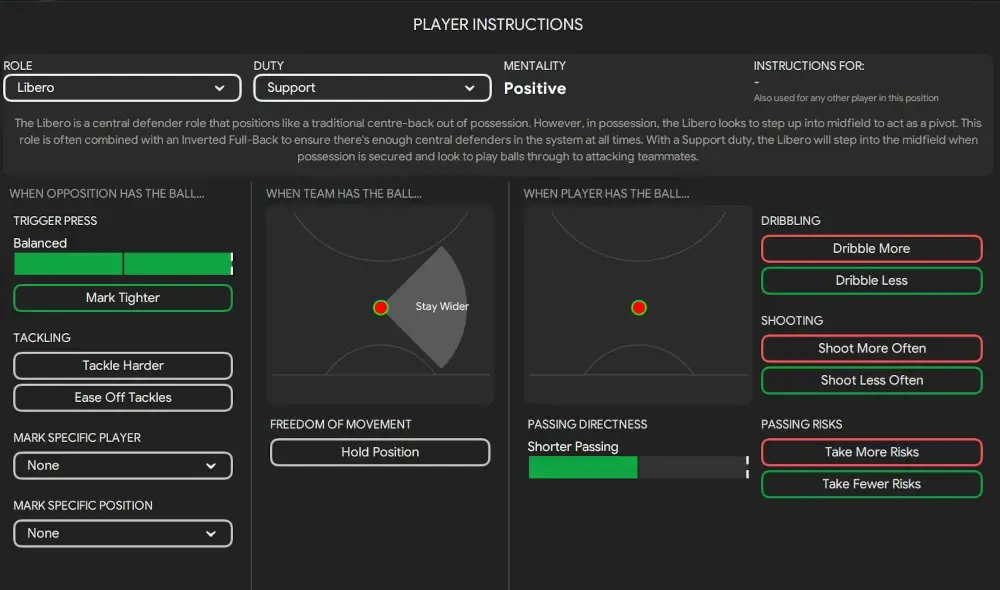
Player Instructions: Hold Position & Close Down Less
The libero will push up into the midfield and provide a free man in the middle of the pitch to increase the number of passing options. His positioning may force the opposing wingers to tuck inside, which can open up passing lanes towards the wingers.
In possession, the libero will be rather unpredictable with the ball. Tasked to take less risks with the ball, his role is to simply move the ball to a more creative player as soon as possible and use his positioning to create overloads in the middle to improve ball circulation.
When the team is out of possession, the libero will drop into the defensive line forming a traditional back four.
DR / DL: Inverted Fullback – Defend
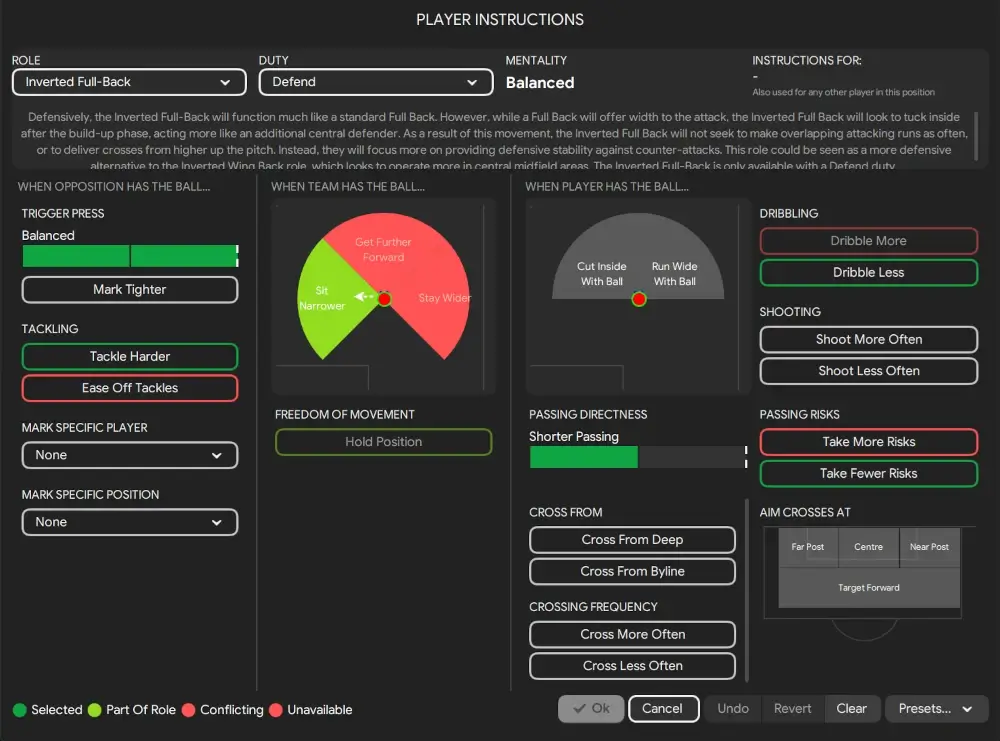
On each of the sides of the central defender, I’ve gone with two defensive inverted fullbacks. Like the central defender they will protect from counter-attacks by holding position and not advance too far forward.
Their positioning will also see them stay close to the central defender – meaning they are protecting the half space channels from movements and threaded passes. To ensure they aren’t caught out of position, I’ve asked them to press less often and dribble less.
Their role and player instructions sees the player’s less likely to make overlaps down the flanks which results in the wingers needing to deal with the opposing fullbacks on their own. Instead the IFB will cover the area behind available for supporting passes and provides the team an opportunity to retain possession by turning play to opposite flank or play diagonal passes towards the center.
It’s only occasionally they will move forward and overlap the midfielders but when there are rather risk-free situations like this, it could be a chance to enter final third with a cross from wide.
DMC: Deep-Lying Playmaker – Defend
In front of the back four, I’ve interpreted Rodri’s role as a Deep-lying Playmaker. He tended to push out of his position and harass the opposition to try to close them down now and then. His heat map shows he covered large areas of the pitch – always making himself available for a pass and using his technique and creativity to dictate play from deep.
Rodri was also the one getting the most touches on the ball throughout the season by making 82.7 passes per game at 91.3% pass accuracy. At the same time, he made the most long balls of the outfielders with 4.8 long balls per game.
Due to these statistics, Rodri’s role could also been interpreted as a Deep-Lying Playmaker on Support. Or, you could ask the DLP-D to Take More Risks when in possession to increase the number of through balls. If so, you need to untick Pass shorter instructions.
Another option, which I used for FM23, is the Regista role. The Regista in Football Manager will swiftly vary between a more cautious approach where he retains possession with devastating through balls that enables the team to come to a goalscoring opportunity by feeding the forward a penetrating ball. His direct passes and eagerness to advance play into final third could let you experience some brilliant moves.
P.S. There was also a question of selecting the Defensive Midfielder-Support role in FM23 too, due to its Aggression, Tackling and capabilities out of possession but I favored the Regista’s in possession capabilities instead.
MCL: Mezzala – Support
Player Instructions: Pass it Shorter, Dribble Less and Shoot Less Often
For Ilkay Gündogan’s role in the 3-2-4-1 tactic I’ve gone for the Mezzala-support role. This enables him to move between the lines and find pocket of spaces to take advantage of. Even though he tends to stabilize the midfield by holding position deeper than Kevin de Bruyne, his off the ball movements makes him a dangerous player in the attacking transition.
With move into channels turned on, the player will offer those necessary third man runs and the player will look towards him when play is on the left side.
Another option is to select the Advanced Playmaker Support role or the Central Midfielder Attack role if you want to use underlaps as a method to create chances in the middle.
It’s not uncommon to experience the player getting between 60 and 90 passes per game with 3 to 6 key passes per game.
MCR: Mezzala – Attack
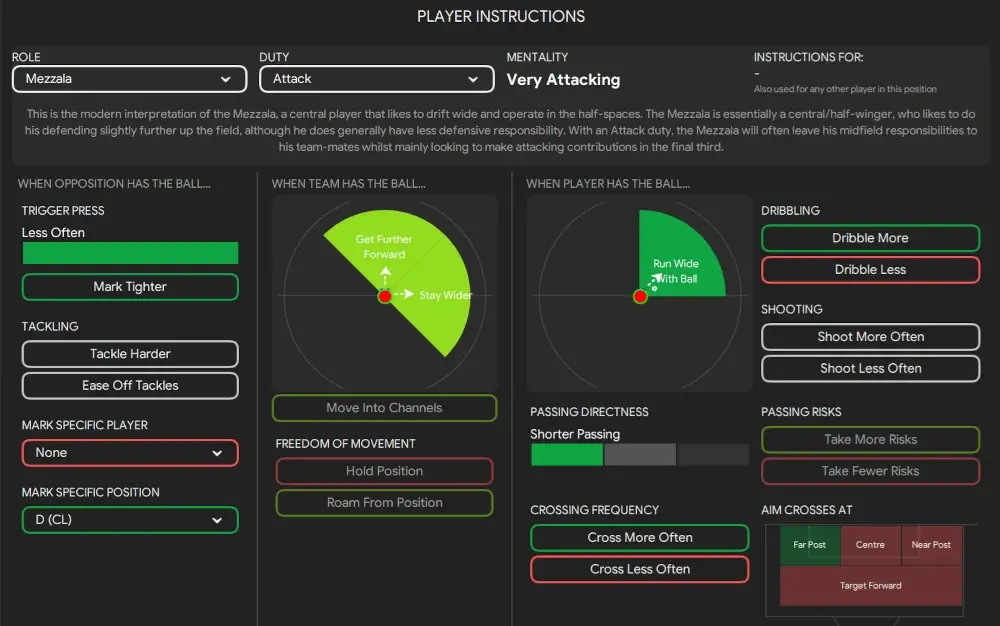
When it comes to replicating Kevin de Bruyne’s role at Manchester City we have a number of options. We could have selected the Central Midfielder – Attack role, if we consider Kevin de Bruyne’s high pressing and tendency to push ahead of the forward by aggressively pushing into space, which was the case against Arsenal where he looked like a second striker.
Another option is to move the player into AMCR position and use the Shadow Striker*.
*How he carries the ball into more dangerous positions before making a killer pass could resemble the SS-A.
Instead, I’ve interpreted Kevin de Bruyne’s role as a Mezzala on Attack duty in this system. It enables the player to take full advantage of his vision, flair and decision-making by making those penetrating runs and passes that unlocks the opposition team.
Since his role is so advanced we need to enable a number of player instructions to get the player behaving like I want. In possession, I want the player to run wide with the ball in order to get in the appropriate position for a cross towards the far post.
When he got the ball, I want him to make more progressive passes by taking more risks and increasing the length of his passes to be a bit more direct than everyone else. On top of that, the MEZ-A will also come to goalscoring chances and try to fashion out chances for himself by taking long shots or carrying the ball into a more dangerous position from which he can shoot or try a through ball towards the striker.
It’s not uncommon to see the player score the second most goals in your team or be top of the assist chart.
AMCR: Attacking Midfielder – Attack
These were the instructions I set up to replicate Kevin de Bruyne’s role in Man City 3-2-4-1 tactics for Football Manager 2023. I keep it here for referance, just in case anyone imports the FM23 tactics and tries it in FM24.

AML: (Inverted) Winger – Attack
To replicate the role of Jack Grealish I have selected the Inverted Winger with an attack duty. The creators of Football Manager has actually made a significant change to the Winger role by giving you the chance to ask the player to Cut Inside. However, I’ve instead selected specific player instructions to make the role more similar to how Jack Grealish plays both in and out of possession.
When the team is in possession the IW-A will stay high and wide in the build-up. However when he receives the ball he will try to either cut inside and overload the left half space channel or make crosses from the flank towards Haaland.
The instructions of the Inverted Wingers are mostly similar with the only difference that the right IW got Support duty instead of Attack duty,
With the ball, they can either make diagonal passes towards the striker, or carry the ball into a more dangerous position by moving inside.
When carrying the ball, they attract the attention onto themselves – giving space for the two attacking midfielders to get the ball in between the channels. Time and time again, we’ll see goals scored from those through balls from the inverted wingers towards zone 14.
Preferred foot: Left
AMR: Inverted Winger – Support
On both wings, I’ve selected the Inverted Winger role. Their role and instructions are mostly similar with the only difference of the AMR who is on a support duty. The right IW will close down more often and man mark the opposite fullback (DL).
Both of them will stay wider and hold position in the build-up but may cut inside to overload the half space channel.
Depending on which player you got in this position, it could be a question of using the Inside Forward role or Advanced Playmaker role but it’s important that the player stays wide to free up space for the attacking Mezzala.
Preferred foot
– Right Side: Left
ST: Pressing Forward – Support/Attack
Player Instructions: Shoot More Often, Pass it Shorter (& Moves Into Channels*)
*Support Duty
The first things that pops to my head when hearing the name Erling Haaland is goals, shots, brilliant movements and runs. Have the world ever seen a more determined and goal-hungry player? A player that’s at the right place at the right time and position himself inside the penalty box like a striker in his thirties…? Or, how he uses his acceleration and physic to gain advantage of his opposing marker by moving like a ballet dancer or a gymnastics.
Over the course of the last three months, I feel there are more to Erling Haalands game than solely being labelled as a Poacher or Advanced Forward. It would perhaps be allright to select the Advanced Forward role in FM24 if you only want the player to score goals, but I want the striker to do much more than simply tapping the ball into the net.
Like Pep Guardiola have asked for, Erling Haaland has tried to get more involved in the game by dropping deeper and holding up the ball. He even makes flick-ons and through balls which makes me feel his role now adays is more similar to the Pressing Forward role than AF-A.
Out of possession, Haaland tends to put extra pressure on the goalkeeper by chasing loose balls or close down the opposing defender to force him to a specific side contrbuting to the teams pressing scheme by denying passing options and better the circumstance for the players behind to win back possession high up the pitch.
With a support duty, the player will ehave more similar to a deep-lying forward – holding up play and combining with the two advanced midfielders on either side of him who moves into channels. He will be les likely to make runs in behind the defensive line, or carry the ball over longer distances which makes the PF-Attack duty more suitable if you prefer a more direct player. It all depends how you see him.
General Performance
Current statistics is gathered by simulating the tactic with Manchester City in FM24 24.0.0.1 Match Engine.
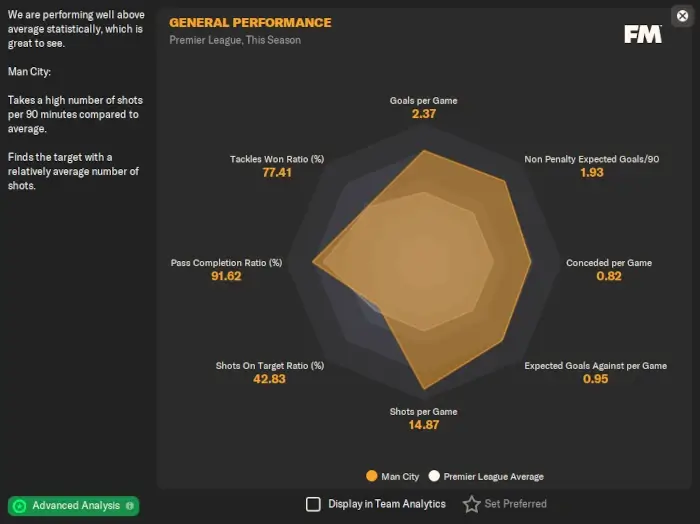
Besides a great number of goals scored per game and being defensive solid, the tactic does brilliantly in possesion. Like any of my possession tactics, it produces lots of games with possession above 65% possession.
With Man City it ended at 63% possession and 24460 passes completed at 91% accuracy.
*These statistics may change for the better, or hopefully not worse, according to future patches. The current FM24 24.0.0.1 ME has its issues with both passing, defending and some player positionings.


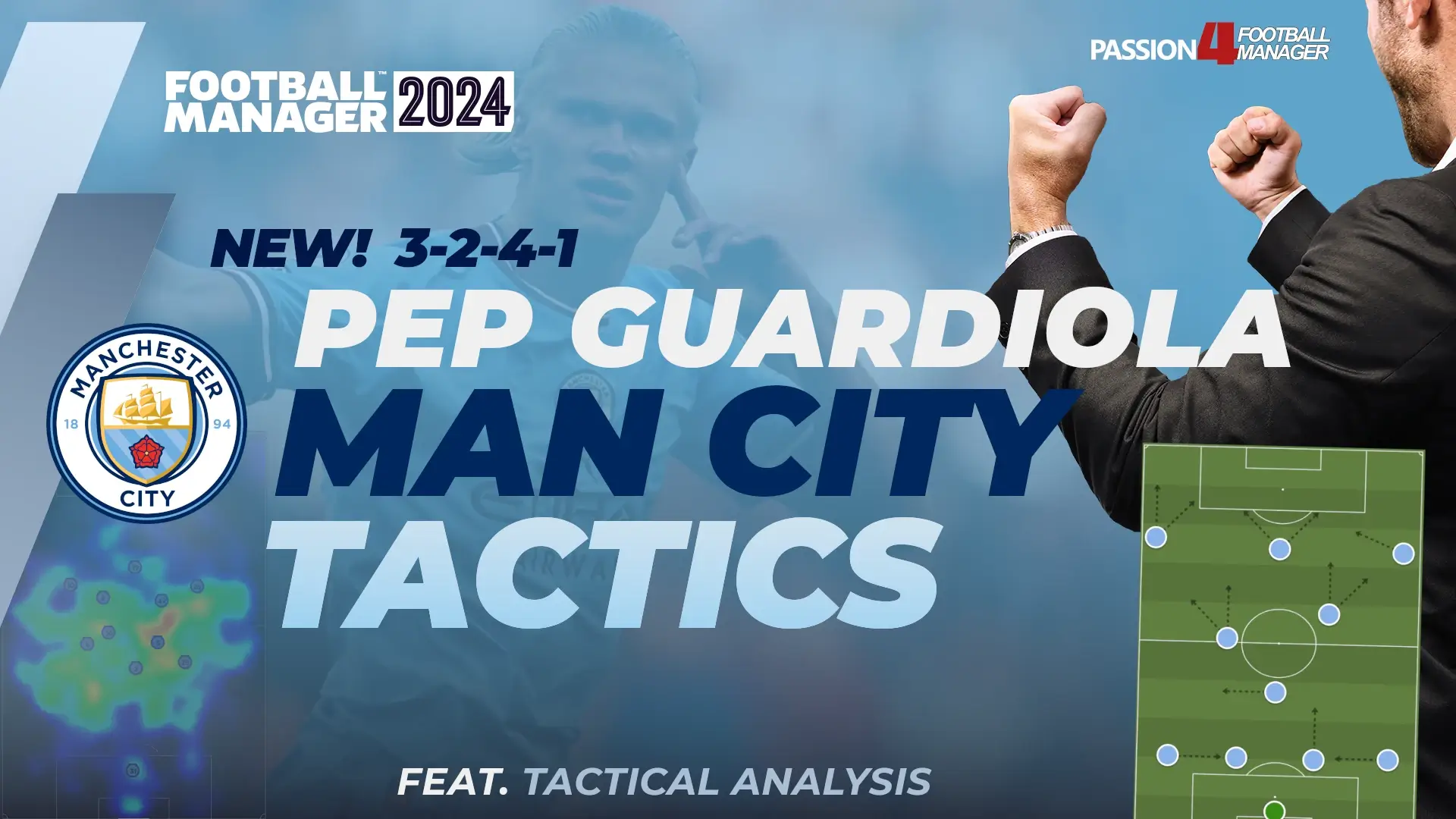
20 Comments
The latest tactic in FM24 doesn't work, it has a lot of possession but creates almost nothing. Could you update it
Sorry to hear about that! I won't take time to update the tactic now as I have my hands full with other projects – unfortunately!
hi espen, do you think this tactic works with the winter update too? or are you working on other solutions?
Hi, I read that there was an update on March 6, 2024, what's new? Are you by any chance preparing new content for when the new update is available?
Thank you
No other update than some page speed fixes
Hi, Will the training schedules be updated to use for this? The megapack doesn't seem to work on this year's version and they've been excellent for the last couple of fms. Thanks
Hi, the work on training schedules has started! Just a major job testing them out and trying to make them effective! hopefully out soon!
atualizou para o FM 24 ??
I'm trying the tactic and I don't think it works at its best. I have a lot of possession (sometimes even reaching 70%) but I make few shots on goal and create very few opportunities. Is this due to the level of my team? or do I need to do something to improve?
alternatively, can I continue to use the 2-3-5 of fm 2023 on the save of fm 2024? Thank you
The new 24.2 ME seems to reduce the number of chances and goals slightly.. But your question is impossible to answer without any more flesh to the bone. I can't give you an appropriate answer without more information. As you probably know, everything depends on your players abilities, your form, squad morale, team cohesion (dynamics), the opposition and their shape and playing style and last but not least training schedules appropriate to the tactics. Now, you will probably ask for my training schedules megapack and think that's the answer or that it's solely the tactics fault… but the answer can be a mix of everything. It's like asking me why it's raining today. However, I do believe the Match Engine is 10% of the answer. If you give me some more information, then it would be easier to investigate. Atm I believe I spent more time updating past content than releasing new which is really demotivating..I will probably do some testing with this tactic for 24.2 ME but it's not first on my priority list as I wish to release new content as well
you're right, sorry, I play with Lazio and I let young players play, I don't use specific training, I let the staff manage them. Are you saying I could use the training magapack you released for Barca's tactics? also, do you have any advice for me on how to make the most of this tactic?
If I may ask, what tactics would you plan to emulate?
Thank you for your patience and for the time you take to answer me!!
I have created a similar tactic since the release of FM 24 Beta that produced amazing results for me personally, but the overall performance has dropped after 24.2. I create slightly less chances than I used to and I've noticed that also my strikers miss some very easy to score chances, especially in the area.
Now, obviously to get the most out of such tactics, you would need to have a very good roster or, be the best club in your country. Lazio is not such. What you also need to consider is, Serie A, is a primarily defensive minded league, and they focus a lot on tactics with 3 at the back which are extremely hard to break when you don't have an elite squad.
In FM 24, more than any other FM, you have to make some adjustments in game after observing how the opponents play against you and how they press you. Against easier sides, do not be afraid to go a bit more attacking and even increase the tempo/pass range a bit. I do believe however that especially in FM 24, Dribble Less kills creativity for the sake of having more passes. So I would try to avoid it if possible.
Also as Espen said, your players will need some time to adjust to a new tactic, especially if they are new to this or the roles are unknown to them (or them being unsuited for the roles). Usually you'll notice better results after the first 1-2 seasons as your team learns the tactic and you improve the roster!
Hope this helps a bit.
The case about tactical familiarity is very important. If a team usually prefers a 3-4-2-1 formation it would take ages to make the team capable of playing a 4-3-3 formation. On top of it, the Pep tactics isn't suitable for any teams as you need the right players. Dribble Less has been ticked to increase the number of passes simply because some people want to see more than 600 passes per game and more one-two's or quick short passes. In my coming Barcelona Tiki-Taka tactic it's taken off.
thanks for the advice, I will use the City players as a reference to improve the team. Do you have any advice on who to buy?
Bro when you releasing it
any idea when this will be released? a time frame?
When is it coming out? I'm so excited i've literally been checking every day lmao.
Hi, I read that the 4-3-3 that was used by the city was also found in the package, right?
I wanted to ask you if, even for this tactic, you have to incorporate a training program like the ones it was recommended to use for Barça's tactics
Thanks, I look forward to the new tactics
When will the Tactic Dowlods be released?
Hopefully soon! Unfortunately haven't had time to work on it as I had imagined.